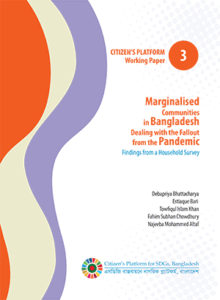
Marginalised Communities in Bangladesh
Dealing with the Fallout from the Pandemic
COVID-19 continues to leave a trail of devastation in its wake. Diminishing decades worth of development progress, the ongoing pandemic impact extends far beyond the health sector. In addition to this, the range and depth of impact vary largely across sectors and communities in Bangladesh. In conjunction with the successive lockdowns disrupting the resumption and continuation of socio-economic activities, the pandemic has exacerbated old vulnerabilities and created new ones. In this vein, the study spotlights the impact and experiences of the previously left-behind (LNOB) and newly pushed-behind (PNOB) communities. Hypothesising the likelihood that the pandemic has aggravated the vulnerability of Bangladesh’s marginalised communities, the study framed the impact assessment of the COVID-19 pandemic on marginalised communities in Bangladesh in three ways. The three dimensions comprise the pandemic’s impact on the health and education conditions of the marginalised as well as the overarching impact on the country’s economy. To this end, the study undertook a face-to-face household survey of 1,600 vulnerable households among the vulnerable communities across Bangladesh to derive trends and relationships whilst reviewing existing literature to validate its findings. The survey was carried out considering division-wise stratification, geo-locations, diversity and susceptibility to experiencing a natural disaster. The study shows that these vulnerable households faced considerable challenges in terms of loss of income, erosion of consumption and savings, health and education. In view of the ground-level evidence, the study emphasises policies to address the predominant rising under-employment, the subsequent reduction in monthly household income and expenses and rising household debt.
Authors: Debapriya Bhattacharya, Estiaque Bari, Towfiqul Islam Khan, Fahim Subhan Chowdhury and Najeeba Mohammed Altaf
Publication Period: November 2021

